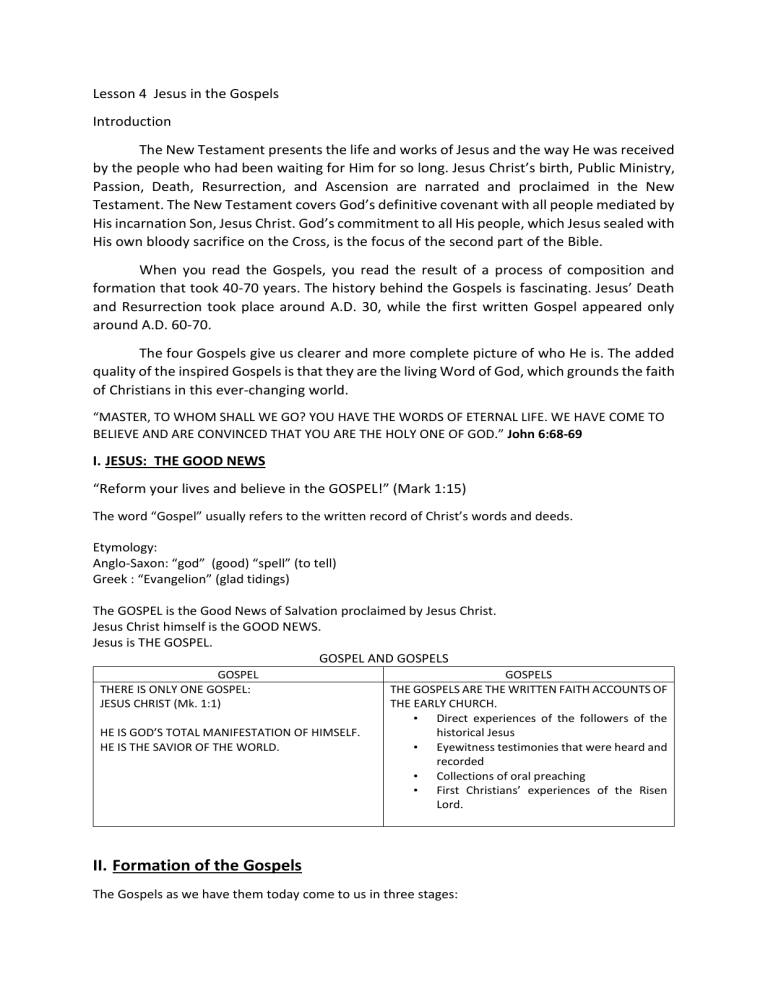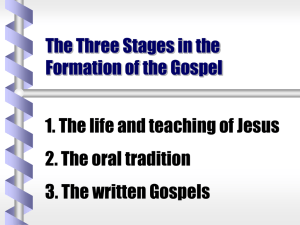
Lesson 4 Jesus in the Gospels Introduction The New Testament presents the life and works of Jesus and the way He was received by the people who had been waiting for Him for so long. Jesus Christ’s birth, Public Ministry, Passion, Death, Resurrection, and Ascension are narrated and proclaimed in the New Testament. The New Testament covers God’s definitive covenant with all people mediated by His incarnation Son, Jesus Christ. God’s commitment to all His people, which Jesus sealed with His own bloody sacrifice on the Cross, is the focus of the second part of the Bible. When you read the Gospels, you read the result of a process of composition and formation that took 40-70 years. The history behind the Gospels is fascinating. Jesus’ Death and Resurrection took place around A.D. 30, while the first written Gospel appeared only around A.D. 60-70. The four Gospels give us clearer and more complete picture of who He is. The added quality of the inspired Gospels is that they are the living Word of God, which grounds the faith of Christians in this ever-changing world. “MASTER, TO WHOM SHALL WE GO? YOU HAVE THE WORDS OF ETERNAL LIFE. WE HAVE COME TO BELIEVE AND ARE CONVINCED THAT YOU ARE THE HOLY ONE OF GOD.” John 6:68-69 I. JESUS: THE GOOD NEWS “Reform your lives and believe in the GOSPEL!” (Mark 1:15) The word “Gospel” usually refers to the written record of Christ’s words and deeds. Etymology: Anglo-Saxon: “god” (good) “spell” (to tell) Greek : “Evangelion” (glad tidings) The GOSPEL is the Good News of Salvation proclaimed by Jesus Christ. Jesus Christ himself is the GOOD NEWS. Jesus is THE GOSPEL. GOSPEL AND GOSPELS GOSPEL THERE IS ONLY ONE GOSPEL: JESUS CHRIST (Mk. 1:1) HE IS GOD’S TOTAL MANIFESTATION OF HIMSELF. HE IS THE SAVIOR OF THE WORLD. GOSPELS THE GOSPELS ARE THE WRITTEN FAITH ACCOUNTS OF THE EARLY CHURCH. • Direct experiences of the followers of the historical Jesus • Eyewitness testimonies that were heard and recorded • Collections of oral preaching • First Christians’ experiences of the Risen Lord. II. Formation of the Gospels The Gospels as we have them today come to us in three stages: Scripture scholars generally recognize that the Gospels were developed in three distinct stages. They are the result of a somewhat gradual process of formation and composition. The three can be visualized as follows: Stage 1: The Historical Jesus Stage 2: Oral Preaching of the Early Church Stage 3: The Written Gospels STAGE 1: The Historical Jesus (Jesus’ Life In Palestine – His Words And Deeds) The Gospels basically have their roots in the words and works of Jesus of Nazareth and in His interactions with his disciples and other groups with which He came in contact with. Jesus proclaimed the Good News of our salvation with authority He performed many miracles He chose 12 men as his apostles whom he would send to carry out his work after his time on earth had been completed He commissioned his apostles to preach his message of salvation to all nations and promised them that He would send His Holy Spirit to enlighten and empower them as they spread the Good News throughout the world Before Jesus went back to His heavenly Father He gave the following instructions to His disciples: Go into the world and proclaim the good news to all creation. (Mk.16:15). Jesus came to live among us. His whole life was a revelation of God. Through Jesus, God lived among us and made Himself known to us. Jesus’ actions are God’s actions. Jesus’ words, instructions and parables are God’s words to us. STAGE 2: Oral Preaching of the Early Church (The Early Christian Communities) Written Gospels were not at the top of the list of activities of the early Church. After the Easter experience and the giving of the Holy Spirit on Pentecost, the apostles and disciples were burning with zeal to spread the good news of Jesus’ victory over sin and death. Led by Peter, and later by Paul, there was a burst of missionary enthusiasm which preached the message of Jesus throughout the Roman (Mediterranean) world. Part of the early preaching, incidentally, was that Jesus was to return in glory very shortly, during the very lifetimes of the apostles. Thus, it did not make much sense to write down eyewitness testimony in these early years if the world was to end soon. What would be the point of it? The disciples faithfully carried out this mission. After they had received the Holy Spirit they started to preach about Jesus and all he had done and said. According to Charpentier, Etienne on How to Read the New Testament,1981-1982, pp 1011 the resurrection of Jesus and the coming of the Spirit at Pentecost enabled the disciples to begin to discover the mystery of Jesus. These disciples remained Jews, but they formed an amazing group within Judaism: they were the witnesses to the Risen Jesus. The disciples sought to be faithful in two directions: to Jesus, and to the life which raised a great many questions. It was an attempt to answer these questions that they began to recollect what they remembered of Jesus. However, they did this in the light of the resurrection. These memories were focused on three points: 1) The disciples preached, to proclaim the Risen Jesus: first to the Jews and then to the Gentiles. Here we have the announcement of the faith of the first Christians; 2) The disciples celebrated their Risen Lord, in the Liturgy and above all in the Eucharist. The Eucharist determined the form of many memories of Jesus; 3) The disciples taught the newly baptized, and in order to do so recalled the actions and the words of Jesus. The community’s memory of Jesus was kept alive by making collections of his sermons, parables, his great works (miracles) and key sayings. These collections─later to be used by the Evangelists─were used in the early liturgies, in the preaching and instructions for the new converts. With eyewitnesses and close disciples still alive and testifying to what they had seen and experienced, no one really thought to write a biography of Jesus. The Gospels had to be written so that the Christian community could measure the preaching of certain teachers against the authentic tradition and remembrance of Jesus. A second practical reason why written Gospels had to result was that the eyewitnesses were beginning to die or be martyred. The early Christians were in fact wrong about their belief in the early return of Jesus. Again, to preserve the authentic testimony, the Good News of Jesus was committed to writing. Thus, we are brought to the third stage – the stage of the written Gospels themselves. STAGE 3: The Written Gospels (The Evangelists) There is only one real gospel (“good news”), and that is the gospel of Jesus Christ – he is the good news. But the Church recognizes four authentic, inspired written communal faith expressions of this good news. These faith expressions we call the Gospels. Three of these Gospels: Mark, Matthew and Luke are called synoptic Gospels. Scholars noted that when Matthew and Luke composed their Gospels, they relied on a version of Mark’s Gospel. If you line up Mark─Matthew─Luke in parallel columns, you would note that there are many similarities, indeed that they can be “read together” (syn─together; optic─look at). Hence, the term “synoptic Gospel.” The version of the Gospels will differ slightly because they were composed by different men writing at different times and in different places. They also present varying points of view because of the particular audiences being addressed. Each Gospel is tailored to the particular concerns of a particular kind of community. They all present the good news of Jesus, but adapt their presentation to the religious needs of the intended audience. With these points in mind, please study each of the evangelist presented. It is worth noting that the authorship of each Gospel is still disputed. What is given below is the generally accepted (or most commonly held) theory of authorship. The Portrait Of Jesus According To The Four Evangelists Matthew (A.D. 65) Matthew was a tax collector. When Jesus called him, Matthew get up and follow me, Matthew followed Jesus and became a disciple. Matthew was very familiar with Palestine. He has a very thorough knowledge of the Old Testament and of the practices and customs of the Jewish people. This made him a good teacher. Purpose: Mt. wrote his Gospel for the Jews. The Jews were familiar with the promises made by God in the Old Testament. In His Gospel, Mt. wanted the Jews to understand that God’s promises had been fulfilled in Jesus Christ. He presented Jesus as the new Moses, pointing out that Jesus belonged to the house of David. Characteristics: Mt. did not follow the sequence of events of Jesus’ life. He gave more attention to Jesus’ words and instructions together in the five central sermons. The rest of he material in his Gospel was arranged around these five sermons. Matthew referred frequently to the Old Testament, because he wanted the Jews to believe that God’s promises in the Old Testament were fulfilled in Jesus. - Link between Old and New Testaments - Jesus is the true Messiah, the fulfillment of Old Testament prophecies - A Jew writing to fellow Jews - Systematic use of Jesus’ sermons - Key chapters: 5-7 – Sermon on the Mount Mark (65 A.D.) Mark had not been a disciple of Jesus, nor had he met Jesus in person. He was a convert to the Christian faith. He belonged to a Jewish family. Mk was born in Cyprus but later transferred to Jerusalem where he was converted. Soon afterwards he joined the disciples on their mission tours, first with St. Paul and later with St. Peter. Purpose: Mk wrote his Gospel for the persecuted Christians of Rome. He presented Jesus to them as the suffering servant of God. This served to console hem and gave them strength in their sufferings and trials. Characteristics: Mk’s Gospel is the shortest of the four. It focuses its attention on the deeds of Jesus. He arranged the materials according to the regions in which Jesus worked. He introduced Jesus in two stages. In the first part of his Gospel, he described Jesus’ marvelous deeds. In the second part, he makes us understand the true mission of Jesus. - The gospel of action (emphasizes works more than words) - Writing to Romans - Starts with John the Baptist - Short and rugged gospel Luke (A.D. 75) Luke belonged to Greek family in Antioch. He was physician by profession and was a welleducated man. He was converted to Christianity at the time when his hometown became the center of missionary activity. He joined St. Paul in his missionary journeys. He stayed with Paul when Paul was prisoner in Rome. Purpose: Lk. Wrote his Gospel for Greek converts. He presumed that they had already catechetical instruction and intended to confirm and further explain it. Characteristics: Lk’s Gospel follows Jesus on his journey from Galilee to Jerusalem. It stresses that salvation is universal, intended for all mankind. Lk’s Gospel speaks of Jesus’ kindness towards all people. It also brings the joy and happiness which the Good News brigs - Written for Theophilus, a Roman official - Christ is savior of every person, not Jews only - Reflects doctor's heart - Great joy - Gospel of prayer John (A.D.90-100) John’s Gospel came much later than the synoptics and was only written in the year 95. John was the disciple whom Jesus loved most. He was the son of a well-to-do fisherman. Before he became one of the twelve apostles of Jesus, he had already been a disciple of john the Baptist. John witnessed some special events in the life of Jesus, such as the transfiguration. Purpose: John wrote his gospel for Christians who were already familiar wit the synoptics. He wanted to give to mature Christians a more profound insight into the personality of Jesus. Characteristics: John did not repeat what could already be found in the other gospels. In the conviction that God is love, he stressed in a very special way Jesus’ teachings on charity. This fourth gospel furthermore contains many reflections on the mysterious personality of Jesus, on His unity with the Father and the Spirit and on Jesus’ divine origin. - Written to everyone - Established deity of Christ - Not so much on what Jesus did as what kind of person He was - Great themes: light, life, love, truth, the Father-Son relationship - John 17 -- High Priestly prayer





